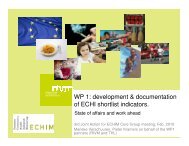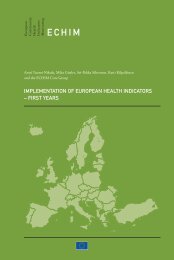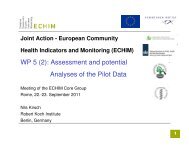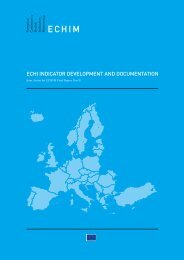INDICATORS
ECHIM Final Report
ECHIM Final Report
You also want an ePaper? Increase the reach of your titles
YUMPU automatically turns print PDFs into web optimized ePapers that Google loves.
Notes: WHO recommendation: daily availability of at least 2 portions (approx.150 g/p/d)<br />
of fruits per day. Although food availability and consumption both provide relevant<br />
information, food availability and consumption are often not synonyms and that needs to be<br />
reported and taken into account when interpreting the data.<br />
Monitoring Public Health Nutrition in Europe -project’s recommendation is below<br />
100 g/day.<br />
50. CONSUMPTION/AVAILABILITY OF VEGETABLES<br />
Definition: Average amount of vegetables (excluding potatoes and juice) available per<br />
person, per year (in grams).<br />
Calculation:<br />
1) Average amount of vegetables (excluding potatoes and juice) consumed (grams) per person<br />
per day, as obtained from household budget surveys (HBS). And percent of population<br />
below consumption of 300 g/day. Exact amount in grams to be decided later.<br />
2) Average amount of vegetables (excluding potatoes and juice) consumed (grams) per person<br />
per day, as obtained from national food consumption surveys using food diary. And percent<br />
of population below consumption of 300 g/day. Exact amount in grams to be decided later.<br />
3) Percentage of people eating vegetables (excluding potatoes and juice) at least daily, derived<br />
from EHIS question FV.2. How often do you eat vegetables or salad (excluding juice and<br />
potatoes)? 1. Twice or more a day / 2. Once a day / 3. Less than once a day but at least 4<br />
times a week / 4. Less than 4 times a week, but at least once a week / 5. Less than once a<br />
week / 6. Never.<br />
Notes: WHO recommendation: daily availability of at least 3 portions of vegetables<br />
(approx.250 g/p/d) on a daily basis. Although food availability and consumption both<br />
provide relevant information, food availability (at least the way FAO collects it), and<br />
consumption are often not synonyms and that needs to be reported/taken into account when<br />
interpreting the data.<br />
Monitoring Public Health Nutrition in Europe -project’s recommendation is below<br />
300 g/day.<br />
51. BREASTFEEDING<br />
Definition: Percent of newborns breastfed exclusively or partially at the age of 6 and 12<br />
months.<br />
Calculation:<br />
1) WHO: percent of infants reaching their first birthday in the given calendar year who were<br />
breastfed, at least partially, when they were a) 3 and b) 6 months of age.<br />
2) Peristat/Nutrition projects: percent of newborns (exclusively) breastfed at first 48 hours<br />
and at 6 months.<br />
3) Child Health Indicators of Life and Development (CHILD) project: a) Percentage of<br />
newborn children exclusively breastfed at hospital discharge or immediately after birth. b)<br />
Percentage of all 6 month old children exclusively breastfed at 6 months. c) Percentage of all<br />
12 month old children receiving breastfeeding at 12 months.<br />
113










